Making Chocolate Beer Truffles
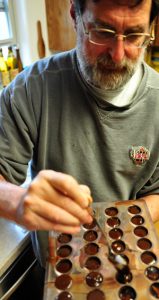 How to Make Chocolate Beer Truffles:
How to Make Chocolate Beer Truffles:
I am excited to share with you original Chocolate Beer Truffles that Pete Slosberg (creator of Pete’s Wicked Ale and founder of Cocoa Pete’s Chocolate Adventures), friend Arie Litman and I created. We sipped a selection of brews as conversations on flavors from different beer styles and how they compare and contrast against the complex nuances found in chocolate echoed through the kitchen. These Chocolate Beer Truffles can be made for Valentine’s Day, for your chocolate | beer loving sweetheart, made for a chocolate course or just as a sweet snack to have around the house.
Chocolate (or Theobroma cacao) starts as the seeds of a cacao tree. The fruit, also called a “pod,” is surrounded by a white, spongy pulp that, when exposed to air, spontaneously ferments, similar to producing a Lambic fermentation. It’s only after this fermentation that the acids and alcohols from the fruit change the chemistry of the seed, making the bland kernel taste like chocolate. After fermentation, the name used is typically changed from the scientific name “cacao” to “cocoa.” The cocoa beans are then roasted to further enhance the flavor and aroma characteristics of the seed, similar to roasting malted barley.
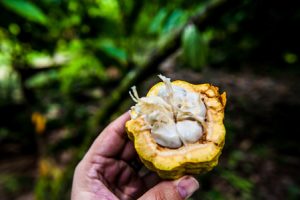
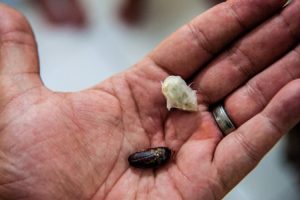
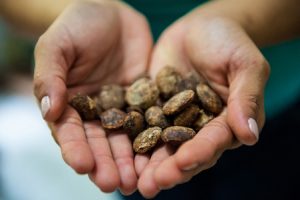
Cacao Nibs:
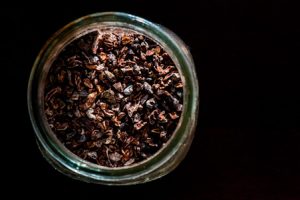 The individual cocoa beans are first fermented, shelled, then cracked, producing an almost spiral-looking edible fragment. Nibs are 100-percent pure chocolate and have a wide range of flavors and aromas reflecting the variety of the source trees, the growing conditions, ripeness of the fruit, the fermentation and finally the roasting techniques. Try adding nibs to the secondary fermenter by dry “nibbing,” similar to dry hopping, adding a cocoa flavor without affecting the head retention of the finished beer.
The individual cocoa beans are first fermented, shelled, then cracked, producing an almost spiral-looking edible fragment. Nibs are 100-percent pure chocolate and have a wide range of flavors and aromas reflecting the variety of the source trees, the growing conditions, ripeness of the fruit, the fermentation and finally the roasting techniques. Try adding nibs to the secondary fermenter by dry “nibbing,” similar to dry hopping, adding a cocoa flavor without affecting the head retention of the finished beer.
Unsweetened Chocolate:
Also known as “bakers’ chocolate,” this form of chocolate is ground cacao nibs processed into a fine paste, sometimes called “chocolate liquor.” Comes in at 95- to 99-percent cocoa.
Bittersweet, Semisweet and Milk Chocolate:
A combination of cocoa, milk (either solids, products or powders), stabilizers, vanilla and sugar. The percentage of chocolate can vary from 90-percent down to 10-percent cocoa. Usually more complex chocolate flavor comes from having a higher percentage of cocoa with fewer fillers. Chocolate with higher percentages of milk products can have flavors of caramel, since the mixture is heated, which causes the milk solids to caramelize.
White Chocolate:
A little over 50 percent of the nib is fat, called cocoa butter. Cocoa butter has no chocolate flavor! White chocolate utilizes only the cocoa butter, and it’s made with milk products and other emulsifiers, a touch of vanilla and other flavorings.
Making a Custom Chocolate Blend:
Do you favor truffles with creamy centers or rich and decadent flavors that leave you reaching for a cold glass of milk? Do you like regional chocolate from particular plantations? How about a chocolate that melts nicely on the tongue, but has more bitterness? When making a custom blend, it is important to think about the flavors and textures of your favorite chocolates. This is especially true for bars and barks, since fillings and creamy centers can distract from the pure chocolate flavor.
First, taste your chocolate. Try different types side by side, as you would in a beer tasting. Take note on how the chocolate breaks on your teeth, how its texture (chalky or milky) coats your mouth and tongue, how it melts and which individual flavors you taste. Next, after the tasting, think about what you liked overall, not as a single chocolate, but as elements of chocolate: taste, mouthfeel, unique flavors—sweet, bitter, creamy, soft. Now take the chocolates that have those characteristics, weigh each and create your blend, noting the results for future reference.
Working with Chocolate: The Art of Confectionery
What is tempering chocolate, and do I have to do it? Tempering chocolate is the technique that creates a smooth, shiny and glossy look to the finished truffles and sets the chocolate’s crystalline structure that results in the final texture. If you choose not to temper, the final products will be dull looking.
Start with two thirds of the chocolate of your choice. Place the chocolate in a double boiler (or a heat-proof bowl over a pot of simmering water, making sure that the bottom of the bowl doesn’t touch the surface of the water). Melt the chocolate to the temperature (113–122°F | 45 – 50°C for dark chocolate) and stir to melt the fat crystals completely. Remove the bowl from the heat (placing on a clean towel to remove moisture) and add half of the remaining third of the chopped chocolate. Constantly folding the warm chocolate over the new addition to cool the chocolate to the cooling temp (82–84°F | 28-29°C for dark chocolate) will improve the chances of a good temper.
Once cool, place the bowl back over the simmering pot and carefully reheat the chocolate back to the melting temp. Remove the bowl, adding the remaining chocolate and cool to below the cooling temp, again folding the chocolate. Then bring the chocolate back to the cooling temp and hold at that temperature. The chocolate is now ready to use for truffle shells, bars or barks.
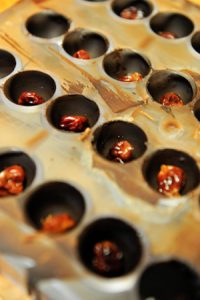 To use the tempered chocolate for molds, place the molds in the refrigerator to thoroughly chill them. One at a time, fill each individual indent with tempered chocolate, then tap the inverted tray to remove the remaining chocolate. Repeat until all the molds are lined with a thin coating of tempered chocolate. Place the tray back into the refrigerator until the chocolate is set. Then the shells are ready to fill.
To use the tempered chocolate for molds, place the molds in the refrigerator to thoroughly chill them. One at a time, fill each individual indent with tempered chocolate, then tap the inverted tray to remove the remaining chocolate. Repeat until all the molds are lined with a thin coating of tempered chocolate. Place the tray back into the refrigerator until the chocolate is set. Then the shells are ready to fill.
Water and chocolate? Not a good combination. If water comes in contact with the chocolate while melting and tempering, it will be absorbed by the sugar in the cocoa and will “seize” or become very grainy and form large lumps, rendering it unusable for truffles. The only solution, strange as it might seem, is to add more water or cream/butter/liquor. Keep adding small doses of liquid until the texture is like syrup, creating a ganache. It can then be used for a sauce over ice cream or swirled into brownies.
Here are several filling options for truffles created during my day with Pete and Arie. Make sure to have your chocolate molds ready, and you will be set for your own day of chocolatiering.
Chocolate Beer Truffle Recipes:
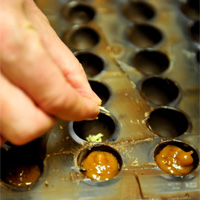

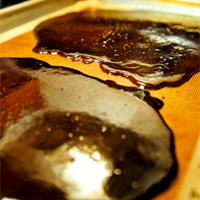



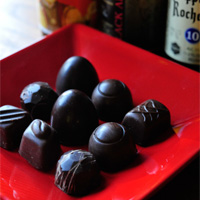
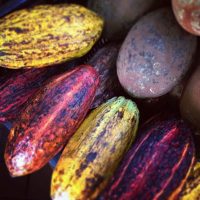
Chocolate Resources:
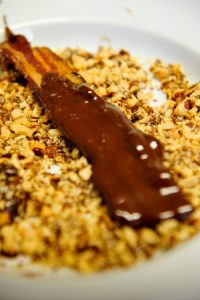
Other Chocolate Recipes:



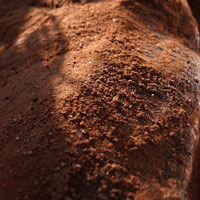

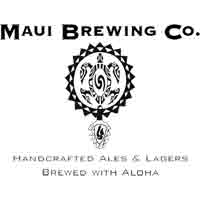


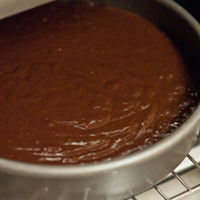
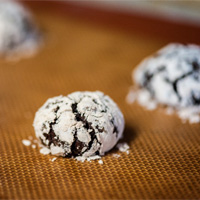

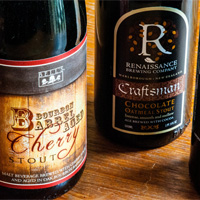


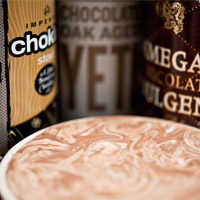
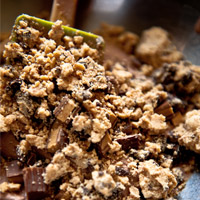

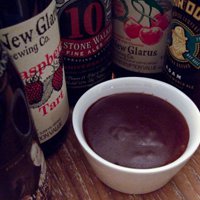
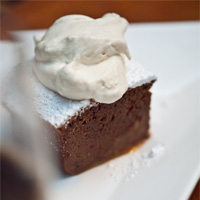



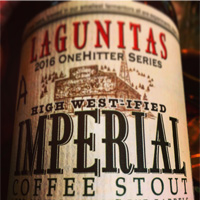
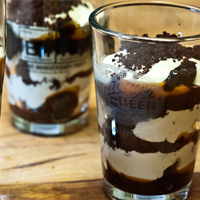


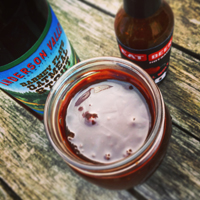


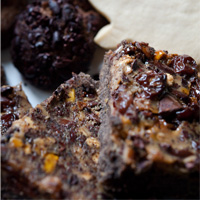
Adapted from BeerAdvocate Magazine: Cuisine à la Bière | Feb 2009 | Issue #25





